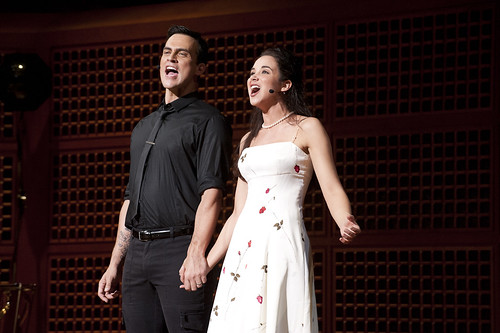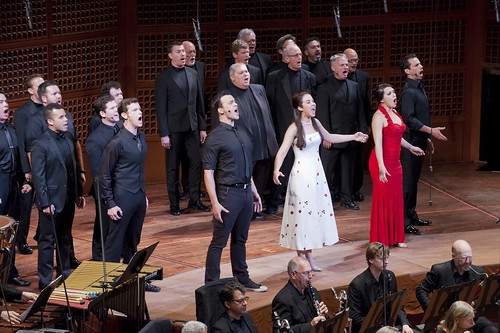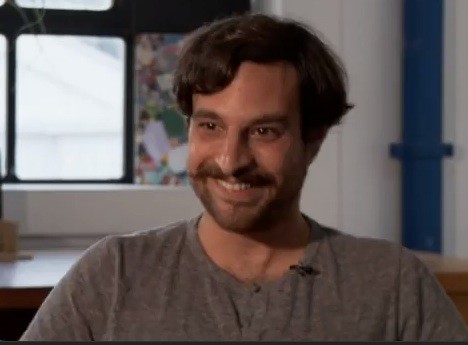
Cheyenne Jackson is Tony and Alexandra Silber is Maria, two star-crossed lovers surrounded by musical theater’s greatest music in the San Francisco Symphony’s season-ending concert of West Side Story conducted by Michael Tilson Thomas. Below: The company performs the Quintet near the end of Act 1. Photos by Stefan Cohen
It’s hard to imagine but it’s true: the music is so glorious you barely even miss the dancing. The San Francisco Symphony concludes its season with the first concert presentation of the full score for West Side Story, and it’s simply mind blowing. For the original 1957 production, composer Leonard Bernstein apparently made concessions in the orchestrations based on what was available to him at the Winter Garden Theatre. Then, when the chance came along to re-orchestrate for the movie in 1961, orchestrators Sid Ramin and Irwin Kostal (under Bernstein’s supervision) went big but perhaps too big. According to Symphony program notes, Bernstein then worried that the work had become “overblown and unsubtle.”
In 1984, Bernstein put together his dream West Side Story for a Deutsche Grammophon recording and finally got the orchestrations he wanted. That’s what we hear in this concert under the astute direction of conductor Michael Tilson Thomas, a friend and admirer of Bernstein’s.
This concert does not preserve any of Jerome Robbins’ original direction or choreography, nor is there much of Arthur Laurent’s book. This is truly a concert concentrating on the score. While Bernstein utilized opera stars like José Carreras and Kiri Te Kanawa for his dream recording, Tilson Thomas wisely goes with more score- and story-appropriate Broadway voices.
This allows the focus to be squarely on Bernstein’s music. Even the lyrics by Stephen Sondheim seem less important when a fully symphony orchestra allows Bernstein’s music to jump, pop and soar so magnificently.
If it seemed like we were watching a recording session, well that’s not far off. Very little attention was paid to directorial flourishes like getting the actors and chorus members on and off the stage efficiently because all the attention was lavished on the music.
From the scintillating prologue to the tear-stained finale, Bernstein’s score has never sounded more vital, more full of brilliance and heart. The relationship between songs like “Maria” and “Somewhere” become even more pronounced as we hear them running as leitmotifs through the piece. And it’s such a pleasure to hear the delicate underscoring of some dramatic scenes, most especially the balcony scene between Tony (Cheyenne Jackson) and Maria (Alexandra Silber) when they profess their love for one another.
Jackson and Silber do an awful lot of kissing (will that come across on the recording?) in an effort to convey the instant and soul-deep connection between Tony and Maria. They do a marvelous job, and Silber especially, with a soaring soprano and a light touch, emerges as a real star. Jackson’s boyish charm carries “Something’s Coming” but his “Maria” is achingly beautiful.
The doomed couple’s improvised wedding, “One Hand, One Heart,” had special poignancy this week. Here are two people in love who want to get married with every cultural and social force around them telling them they are forbidden to do so. The resonance of that in the wake of the Supreme Court rulings involving same-sex marriage only added new depth and even more beauty to the scene.
Julia Bullock makes only one appearance, but it’s a powerful one. She sings a “Somewhere” that is not overstated (easy to do with this song) but captures the open-heart and hope amid oppressive darkness.
The show’s more comic numbers, “America” and “I Feel Pretty” and “Gee, Officer Krupke,” come off beautifully and don’t feel completely out of place as they sometimes can. Having Symphony Chorus members present to beef up the vocal sound is also pretty wonderful.
At only two hours, with the second act being much shorter than the first, you really feel the absence of the book in Act 2 when the tragedies descend. The music conveys a lot, and Tony’s death by gunshot is well handled, but the concert can only take the narrative so far.
Still, when the music is this a live, so full of rhythm and soul and breathtaking beauty, it’s hard to complain about anything. This San Francisco Symphony recording can’t come soon enough.
[bonus interview]
I interviewed Cheyenne Jackson for a story in the San Francisco Chronicle. Read the feature here. (subscription may be required)
FOR MORE INFORMATION
The San Francisco Symphony presents West Side Story at 8 p.m. June 28 and 29 and July 2 and 2 p.m. June 30 at Davies Symphony Hall, 201 Van Ness Ave., S.F. Tickets are $47-$160. Call 415- 864-6000 or visit www.sfsymphony.org.



